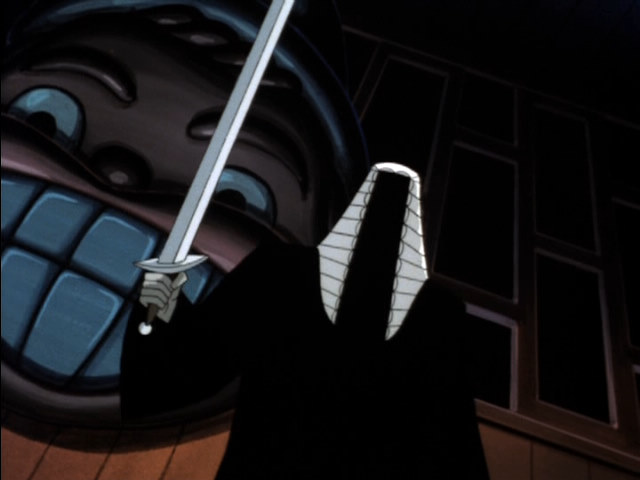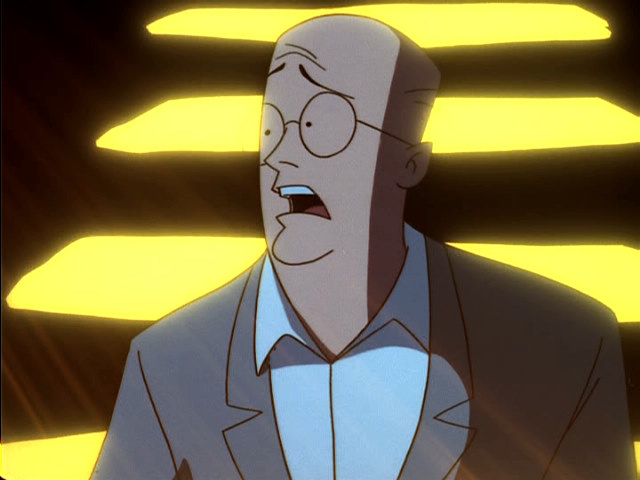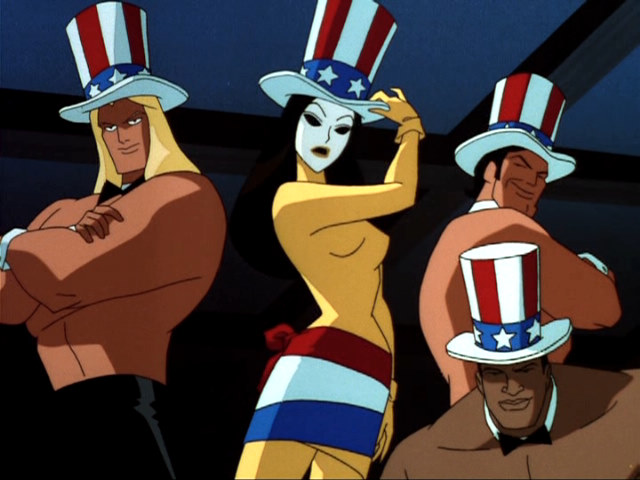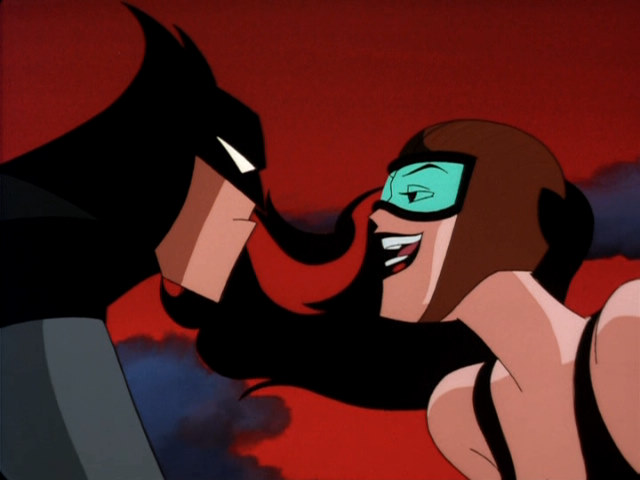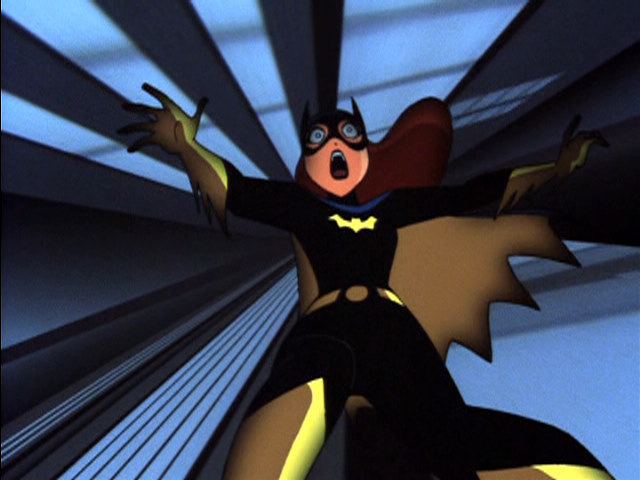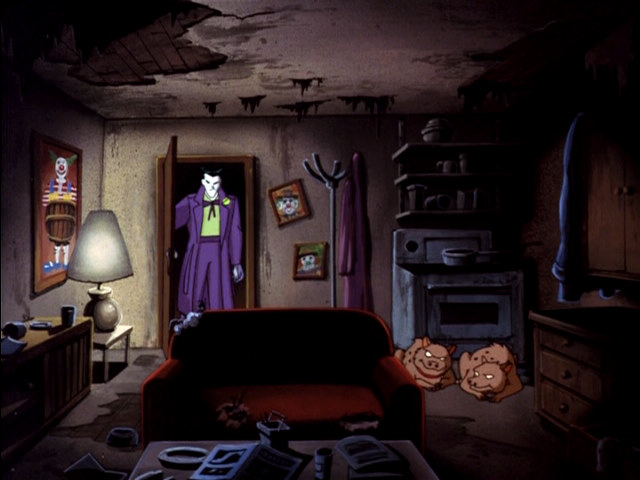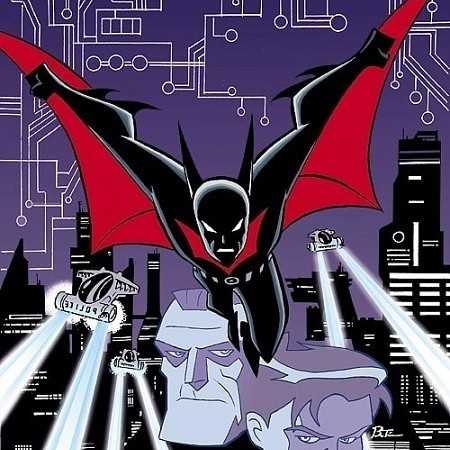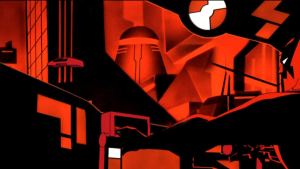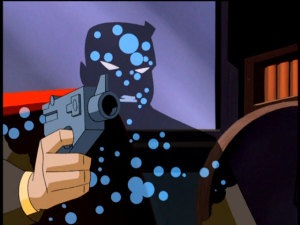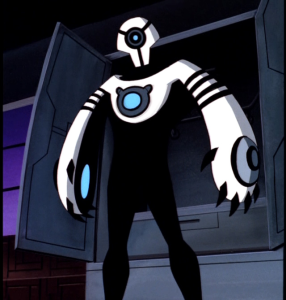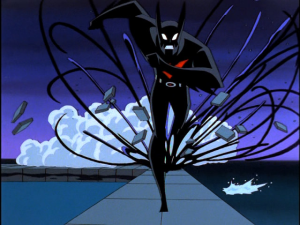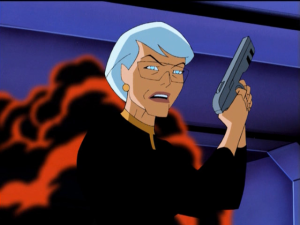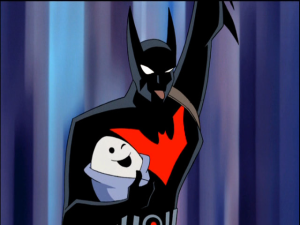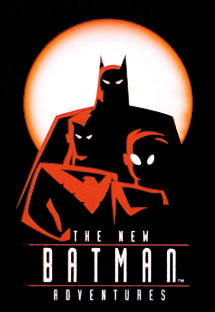 In 1997, Batman: The Animated Series gave way to The New Batman Adventures, which had an edgier attitude. The animation became more fluid and the character designs highly stylized. Gotham gained a more modern look that combined late 20th century yuppie fashion with remnants of the original retro-avant-garde aesthetics. Bruce Timm and company also shook up the status quo: they brought in Tim Drake as Robin (with Jason Todd’s post-Crisis origin), promoted Batgirl to Bruce’s main sidekick (and even more than that, according to the spin-off movie Mystery of the Batwoman), and played with conventions by having Catwoman closely flirt with Nightwing. If anyone could pull it off, though, it was this team – after all, these guys even got away with making Superman sound noirish as hell.
In 1997, Batman: The Animated Series gave way to The New Batman Adventures, which had an edgier attitude. The animation became more fluid and the character designs highly stylized. Gotham gained a more modern look that combined late 20th century yuppie fashion with remnants of the original retro-avant-garde aesthetics. Bruce Timm and company also shook up the status quo: they brought in Tim Drake as Robin (with Jason Todd’s post-Crisis origin), promoted Batgirl to Bruce’s main sidekick (and even more than that, according to the spin-off movie Mystery of the Batwoman), and played with conventions by having Catwoman closely flirt with Nightwing. If anyone could pull it off, though, it was this team – after all, these guys even got away with making Superman sound noirish as hell.
Again, different fans of the comics can find plenty to enjoy:
Although this incarnation of the show doesn’t have that many episodes primarily informed by crime fiction, Judgement Day provides a well crafted mystery tale set among Gotham City’s peculiar underworld, as a violent new vigilante goes after various members of the rogues’ gallery. He calls himself The Judge and if you think Antonin Scalia’s approach to the law is scary, wait until you see this dude literally throw the book at the Riddler!
Some of the most psychologically charged BTAS moments involved villains facing the challenges of reforming. Double Talk, in which a released Ventriloquist struggles to keep his sanity, fits into that noble tradition. Of all the Scarface episodes, this one comes the closest to matching Read My Lips for sheer spookiness.
And then there is the episode where the Bat-gang goes up against Calendar Girl, a supermodel who commits colorful, conceptual crimes together with three semi-naked, bowtie-wearing bodybuilders in order to get revenge on the sexist, ageist politics of the fashion and entertainment industries. While engaging with serious real-world issues in typically idiosyncratic terms, Mean Seasons is above all an orgy of visually delightful set pieces, including an amazing 2½-minutes-long, totally gratuitous fight against a giant robotic dinosaur!
As far as edge-of-your-seat action goes, the episode to beat is The Ultimate Thrill. Introducing the animated version of the adrenaline-fuelled Roxy Rocket (a character first created in the cool Batman Adventures Annual #1), this episode makes great use of the new, slicker animation style through a series of frenetic chases, mostly through the air. Keen, clear, and exciting: current Hollywood could learn a thing or two from these guys!
The most out-of-the-box plot can be found in the brutal Over The Edge, which starts with cops shooting at Batman and blowing up the Batcave while Commissioner Gordon yells at a megaphone ‘Bruce Wayne, stop where you are!’ What is more incredible, the episode manages to downright top that scene every couple of minutes, never letting go until a denouement that feels, not like a shameless copout as you might expect, but like a well-earned, powerful payoff.
Finally, the most amusing episode of this era is Joker’s Millions, which has a lot of fun with the Joker’s relationship with money. It includes an almost Mel Brooks-like barrage of one-liners and sight gags.
Having proven their superior skills with a streamlined (yet relatively conventional) take on the Caped Crusader, the animated team then went on to reinvent the wheel. Batman Beyond moved the continuity decades into the future, where an aged Bruce Wayne tutored a teenage Terry McGinnis into playing the role of the Dark Knight in a cyberpunk Gotham City.
What could have been just another series about a young, impulsive hero with a wise mentor was in fact able to carry the weight of the backstory established in the previous shows, creating a reality that drew on Batman mythology yet also felt fresh and daring. The new status quo brought forth interesting identity questions about what really defined Batman (given a neat visual depiction in the episode Lost Soul, where Terry had to fight the Batsuit itself). The overall look seemed straight out of Akira and the soundtrack was now made up of techno music and industrial rock. The plots revolved around teen issues and sci-fi themes – if BTAS had often been about rogues with sympathetic motivations taken to violent extremes, Batman Beyond’s villains usually reflected technology’s destructive impact on their body and eventually their mind.
For all these radical departures, there were still recognizable elements. April Moon was a rare, film noir-inspired episode. Sneak Peek showed a villain’s tragic rise and fall in the tale of a ruthless techno-paparazzo. Shriek, which was full of memorable moments, introduced a rogue with a creative sound-based gimmick (one that worked in ways it never could have on a comic). Black Out provided tremendous fight scenes with the malleable assassin Inque (and so did the sequel, Disappearing Inque). Eyewitness was the show’s take on Over the Edge, as Commissioner Barbara Gordon had the police hunt down Batman after he killed Mad Stan, a terrorist bomber who hilariously spoke only through rants made up of enraged libertarian clichés. The Eggbaby was the obligatory episode played for laughs – successfully so – with Terry having to take care of an electronic baby while battling a gang led by Ma Mayhem (‘A tabloid gave her that name. It was the golden age of alliteration.’). And if the first seasons were still quite hit-and-miss, by the third season almost every episode topped the previous one in terms of utter coolness.
One tale set in the Batman Beyond universe managed to combine all elements. The direct-to-video film Return of the Joker included a cleverly constructed whodunit, the Joker at his sickest, an over-the-top climax, hardcore action, and an unforgettable, subversive twist on the Batman family, as well as some pitch-black comic relief. Yet be warned: the film – especially in its uncut version – is dark enough to make Christian Bale sound like Adam West.
At the end of the day, whether you’re a long time comics reader or just taking your first steps in Gotham City, the Bruce Timm-produced animated shows are a great place to get your bat-fix, if nothing else because they were created to be accessible to everyone – from kids to parents, from diehard fans to casual viewers. You don’t need to have read a thousand stories before jumping in and there are no convoluted crossovers to trick you into buying scattered issues just to figure out what the hell is going on… That said, if you really want to know how the whole animated Batman saga wraps up, you’re still going to have to track down the second season finale of the Justice League Unlimited TV series!
But hey, what if you’re a whole different kind of Batman fan? What if you prefer light-hearted escapades, anything-goes superhero fantasy, and larger-than-life adventures in which the Caped Crusader interacts with the rest of the DC cast? Well, in that case, screw the BTAS – just go watch any episode of the wonderfully witty Batman: The Brave and the Bold cartoon:

